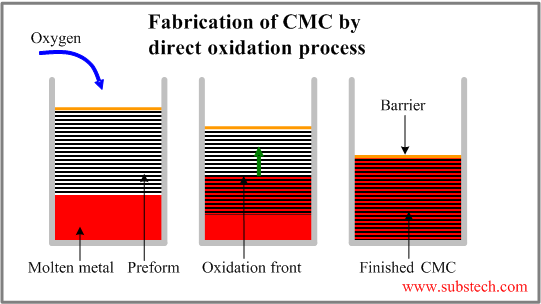to Composites
to Ceramic Matrix Composites
Fabrication of Ceramic Matrix Composites by Direct Oxidation Process
Direct Metal Oxidation (DIMOX) - description
Direct metal oxidation process (Dimox) of Ceramic Matrix Composites fabrication is a type of Reactive Melt Infiltration (RMI) technique, involving a formation of the matrix in the reaction of a molten metal with an oxidizing gas.
Preform of dispersed phase (fibers, particles) is placed on the surface of parent molten metal in an atmosphere of oxidizing agent (Oxygen).
Two conditions are necessary for conducting Direct oxidation process: dispersed phase is wetted by the melt; dispersed phase does not oxidize in an atmosphere of oxygen.
Liquid metal oxidizes when it is in contact with oxygen, forming a thin layer of ceramic with some dispersed phase incorporated in it.
Capillary effect forces the melt to penetrate through the porous ceramic layer to the reaction front where the metal reacts with the gas resulting in growing the ceramic matrix layer.
The melt advances to the reaction front continuously at a rate limited by the oxidation reaction rate.
Some residual metal (about 5-15% of the material volume) remains in the inter-granular spaces of the ceramic matrix.
The resulting materials have no pores and impurities, which are usually present in ceramics fabricated by sintering (binders, plasticizers, lubricants, deflocculants, water etc.).
Commonly Direct Melt Oxidation (DIMOX) technique is used for fabrication composites with the matrix from aluminum oxide (Al2O3). A reinforcing preform (SiC or Al2O3 in either particulate or fibrous form) is infiltrated with a molten aluminum alloy heated in a furnace to a temperature 1652-2102°F (900-1150°C).
The aluminum alloy is doped with additives (e.g. magnesium, silicon) improving the wettability of the reinforcing phase with the melt and enhancing the oxidation process.
The typical rate of DIMOX process is 0.04-0.06”/hr (1-1.5 mm/hr). In principle the direct oxidation process and the oxide growth may continue even after the reaction front has reached the outer surface of the preform. In this case the aluminum oxide will be deposited over the preform changing its dimensions. In order to prevent an advance of the reaction front beyond the preform surface it is coated with a gas permeable barrier. The ceramic matrix growth stops when the reaction front reaches the barrier.
to top
Direct Metal Oxidation (DIMOX) process
- Lay-up. At the lay-up stage the fibrous preform is shaped.
- Application of Interphases. A thin (commonly 0.1-1 µm) layer of a debonding phase (pyrolytic carbon (C) or hexagonal boron nitride (BN)) is deposited on the fiber surface by Chemical Vapor Infiltration (CVI) method.
- Deposition of a gas permeable barrier on the preform surface. The surface through which the melt should wick into the preform is not coated.
- Direct Metal Oxidation. The preform is put in contact with liquid aluminum alloy. The melt wicks into the reinforcing structure through the non-coated surface. The oxidant (air) penetrates into the preform in the opposite direction through the gas permeable barrier. Aluminum and oxygen meet at the reaction front and form the growing layer of the oxide matrix. The process terminates when the reaction front reaches the barrier coating.
- Removal of excessive aluminum. The residual aluminum is removed from the part surface.
Advantages and disadvantages of Direct Metal Oxidation (DIMOX) process
Advantages of DIMOX process:
- Low shrinkage. Near-net shape parts may be fabricated.
- Inexpensive and simple equipment;
- Inexpensive raw materials;
- Good mechanical properties at high temperatures (e.g. creep strength) due to the absence of impurities or sintering aids;
- Low residual porosity.
The disadvantages of DIMOX process::
- Low productivity – growth rate is about 0.04”/hour (1mm/hour). The fabrication time is too long: 2-3 days.
- Residual (non-reacted) aluminum may be present in the oxide matrix.
